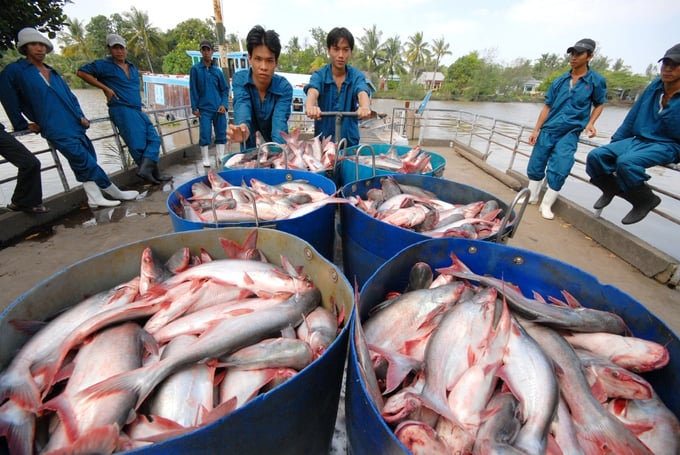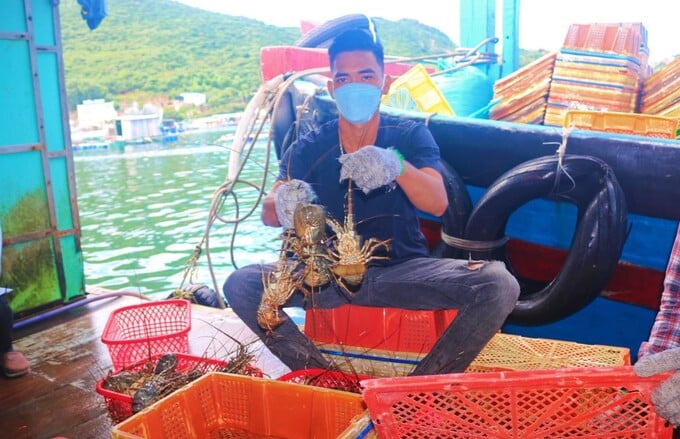June 21, 2025 | 01:25 GMT +7
June 21, 2025 | 01:25 GMT +7
Hotline: 0913.378.918
June 21, 2025 | 01:25 GMT +7
Hotline: 0913.378.918
Truong Dinh Hoe, General Secretary of the Vietnam Association of Seafood Exporters and Producers (VASEP), says that in recent years, China has remained one of Vietnam’s major fisheries import markets, the third largest market with a turnover of over USD 1 billion, averagely 14 - 15% of the total export turnover.
In the first six months of 2023, China has surpassed the EU market, becoming the second largest market for Vietnam's fisheries exports. Vietnam’s fisheries export value to this market exceeds USD 716 million in this period, accounting for more than 17% of the total import turnover to China. In which, shrimp exports reach nearly USD 281 million, down 15.7%, pangasius exports reach USD 281 million, down 34.4%.
Regarding shrimp items, Nguyen Duy Kien, Asia-Africa Market Department (Ministry of Industry and Trade), says that shrimp farming in China is very difficult due to high input costs and low raw shrimp prices, so this country will continue to increase shrimp imports. “China's demand for shrimp imports has gradually recovered with the volume almost doubling compared to the same period last year. However, the price of imported shrimp remained low in the context of global market decline".
As for pangasius, Nguyen Van Dao, General Director of Godaco Seafood Joint Stock Company (Hau Giang), shared that in the first six months of 2023, pangasius export turnover of enterprises to China decreased by approximately 30%. In the case of Godaco, export activities also decreased by 10% compared to the same period last year due to a decrease in demand after the Covid-19 epidemic.

VASEP assesses that pangasius exports will be more profitable than shrimp exports in the near future. Photo: TQ.
VASEP’s assessment shows that among export items, pangasius will be more profitable than shrimp because businesses have existing trade relations with Chinese partners. Vietnamese pangasius can fill the gap of white fish from Russia considering the existing conflicts. Another thing to add is that Chinese consumers tend to consume more pangasius and other freshwater fish. This is also an opportunity for Vietnamese businesses to increase exports.
According to Dr. Nguyen Huu Dung, Chairman of the Vietnam Marine Farming Association, China has a large demand for fisheries products at present, especially in Guangxi, Guangdong and Yunnan. For example, Guangdong can produce and provide a part of seafood, but this amount is not much compared to the consumption demands of the population.
China is still a very "profitable" market because Chinese consumption habit has many similarities to Vietnamese’s. For example, Chinese consumers prefer squid, octopus and lobster, all of which are items Vietnam can offer.
“Vietnamese seafood is easy to export to China, but it is mainly raw. The fresher it is, the higher the value. The Chinese would rather spend their money on a raw, whole shrimp than a shelled or processed shrimp,” said Tran Van Linh, Chairman of the Board of Directors of Thuan Phuoc Seafoods and Trading Corporation (Da Nang).

Chinese consumers prefer fresh seafood. Photo: Hong Tham.
Le Ba Anh, Deputy Director of the National Agro-Forestry-Fisheries Quality Assurance Department, said that Vietnam's fresh fisheries products are favorable for boosting exports to the Chinese market.
First of all, Vietnam has a fairly wide land border and many official border gates with China, which is a great advantage for exporting live and fresh products. Secondly, Chinese families and restaurants prefer fresh seafood in order to have it processed according to local tastes. Thirdly, fresh Vietnamese fisheries products are reasonably priced while having high quality.
China currently allows 48 aquatic species and 128 fisheries products from Vietnam to be exported to this market. The National Agro-Forestry-Fisheries Quality Assurance Department has sent a dossier, requesting to add some objects (salted jellyfish, red swimming crabs, etc.) to the list of permitted export items to China. However, the Chinese side often takes a long time to conduct additional appraisals of enterprises and products.
According to Deputy Director Le Ba Anh, enterprises who want to export seafood to China need to pay attention to a number of issues:
Products must be on the list recognized by China;
Products are packaged and labeled with enough information according to China's traceability requirements;
Each shipment exported to China is assessed and granted a food safety certificate;
Chinese authorities will organize an annual inspection, either in person or online (probability) for enterprises exporting to China or those which commit violations.
Translated by Samuel Pham
![Turning wind and rain into action: [9] Digitizing hydrometeorological data in response to climate change](https://t.ex-cdn.com/nongnghiepmoitruong.vn/608w/files/news/2025/06/17/z6704423696987_15fd32ffc26d590d204d520c9dac6786-nongnghiep-165943.jpg)
(VAN) Farmers have begun accessing hydrometeorological applications to adjust their cropping schedules, aiming to ensure productivity and adapt to climate change.
![Turning wind and rain into action: [8] Real-time salinity detection and early warning technology](https://t.ex-cdn.com/nongnghiepmoitruong.vn/608w/files/news/2025/06/17/z6704423696987_15fd32ffc26d590d204d520c9dac6786-nongnghiep-151127.jpg)
(VAN) Thanks to the integration of modern hydrological-hydraulic models, remote sensing technologies, and artificial intelligence, the accuracy of hydrological forecasting has significantly improved.
![Turning wind and rain into action: [7] Early disaster warnings help marine farmers minimize losses](https://t.ex-cdn.com/nongnghiepmoitruong.vn/608w/files/news/2025/06/17/z6704423696987_15fd32ffc26d590d204d520c9dac6786-nongnghiep-142942.jpg)
(VAN) In recent years, thanks to early disaster warnings and forecasting, marine farmers in Khanh Hoa province have been able to reduce risks and losses, thereby improving production efficiency.
![Turning wind and rain into action: [6] ‘Four on-the-spot’ disaster management software](https://t.ex-cdn.com/nongnghiepmoitruong.vn/608w/files/news/2025/06/17/e5a48259d6a262fc3bb3-nongnghiep-183800.jpg)
(VAN) By simply activating the scenario on the disaster management software, the relevant authorities immediately know how many households need to be evacuated, where to evacuate them to, and by what means of transportation…
![Turning wind and rain into action: [5] Hue applies modern technology in disaster forecasting](https://t.ex-cdn.com/nongnghiepmoitruong.vn/608w/files/news/2025/06/17/z6704423696987_15fd32ffc26d590d204d520c9dac6786-nongnghiep-093938.jpg)
(VAN) In Hue city, modern technology has recently been applied in meteorological and hydrological forecasting and warning, helping to reduce the damage caused by natural disasters.

(VAN) A cutting-edge farming technique being implemented on an experimental ranch in Arizona's Sonoran Desert has already saved a billion gallons of water over five years, according to Civil Eats.

(VAN) Poultry and pig production and the environment can be boosted through enhanced water technology, according to new research.